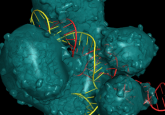Missed targets

Joachim Goedhart (University of Amsterdam, The Netherlands) explores our understanding of the limitations of research technologies and their impact on the accuracy of results.
New technologies enable experiments that have never been done before. Even so, all methods have their limitations. It is crucial to understand and explore these boundaries. Only when the limitations are well defined can new technologies be optimally exploited. In addition, a good understanding of the caveats of a technique will provide fertile ground for improvements. Not knowing the limitations, or ignoring them, can cause a substantial loss of valuable research money and time. This sounds rather dramatic, but these are the implications of a study that was published last year by Jason Sheltzer (Cold Spring Harbor; NY, USA) and colleagues [1]. This study drew a lot of attention, as it reported that several drugs that are currently used in clinical trials kill (cancer) cells through a different mechanism than originally thought. This raises considerable doubt as to the effectiveness of treating cancer with these drugs. A closer look at the technologies that are used to identify drugs in preclinical studies sheds light on the limitations of those methods. The main issue is that off-target toxicity is difficult to distinguish from targeted, specific cancer cell killing. It turns out that off-target effects threaten the development of new drugs at two stages, target identification and validation of the drug action.
Off-target identification
The first step in drug development is to find a good target. Proteins that are essential for cancer cell growth are potential targets. Essential proteins can be identified by removing them from cancer cells. To achieve this, a method that is based on RNA interference (RNAi) can be used. RNAi is a cellular defense system that protects cells against non-self DNA [2]. In this process, double-stranded RNA is used as a template to destruct homologous mRNA. Since its discovery, RNAi has been exploited to knockdown mRNA levels in cells, resulting in a reduced level of proteins that were encoded by the mRNA. RNAi is considered a robust and selective method for the suppression of mRNA levels, leading to a specific reduction of the corresponding protein.
The relative simplicity of the knockdown approach has led to massive screens in which genes have been systematically knocked down [3]. Off-target knockdown is one of the confounding factors of these screens. Here, off-target is the process of interfering with genes that are not the intended target. This can be partially remedied by comparing the results obtained from different interfering RNAs for the same gene. The RNAi based knockdown method was previously used to demonstrate that certain proteins are essential for cancer cell growth. However, the study by Lin et al. showed that getting rid of these proteins with a CRISPR—Cas9 based method did not result in growth defects [1]. Therefore, it was concluded that the RNAi-based method killed cells by an off-target mechanism. Such off-target toxicity of RNAi has for instance been observed for knockdown of MELK [4]. The mechanism for this off-target toxicity is generally unknown.
 What are off-target effects of CRISPR and why are they concerning?
What are off-target effects of CRISPR and why are they concerning?
Gaetan Burgio of the Australian National University (Canberra, Australia) discusses the off-target effects of CRISPR, how they occur, how to avoid them and their impacts on the uses of the technique.
Off-target action
In previous studies, the proteins that had previously been identified to be essential for cancer cell growth were taken as targets for intervention. The idea was that inhibition of the essential protein activity with a drug would result in cancer cell death. Therefore, drugs were developed that inhibited the target protein. The activity of such drugs can be validated by studies with the purified components in a test tube. However, in the end, the drug needs to act within the complexity of the cellular environment. When the main purpose of a drug is to cause (cancer) cell death, it is in general unclear whether the cell death is due to a specific or unspecific activity. It turns out that the drugs examined in the paper by Lin et al. [1] kill cancer cells even when the target protein is not present. The drugs may still selectively target other proteins, but it is entirely unclear what the mechanisms of action are. Therefore, the researchers argue that more stringent testing of the drugs’ activity in cells is required. Strong evidence for specificity would be obtained when a single mutation in the target protein would confer resistance to the drug. This would also contribute to understanding the mode of action.
Conclusion
The limitations of new technologies are often unclear. For established technologies the limitations are often well-documented. Yet, optimism and enthusiasm for a method may push the downsides to the background. This is not necessarily intentional, but it can still be damaging. Being conscious of limitations is a prerequisite for the optimal use of a technology. Therefore, a substantial part of my lectures about the use of GFP as a genetically encoded lightbulb deal with the limitations of GFP technology [5].
Another reason for overlooking limitations is that we often (need to) make assumptions. When a technology works well in the majority of cases, we may become overconfident and assume it is flawless all of the time. This mechanism may have contributed the misidentification of targets based on RNAi results.
Lin et al. observed that, in contrast to knockdown with RNAi, a knockout with CRISPR—Cas9 did not lead to cell toxicity and revealed that the genes were not essential [1]. Therefore, CRISPR—Cas9-mediated mutagenesis seems better suited to identify essential genes. However, it would be a mistake to see CRISPR—Cas9 technology as a problem-free alternative for RNAi. Genome editing with CRISPR—Cas9 has its own set of limitations, although off-target effects are less of a problem [6]. Again, being aware of those limitations will be key to the successful application of this technology.
In research, emphasis is often put on the resulting discovery rather than the new technologies that made it possible. Is it time to focus on the tech?
 A hammer doesn’t need a nail
A hammer doesn’t need a nail




